After having sampled Samsung’s flagship (well, as far as full HD 1080p models go anyway) F8000 series of LED LCD TVs, we’re naturally keen to find out whether its highly accomplished image quality has filtered down to step-down ranges. In for review today is the Samsung UE46F7000, a 46-inch version of the Korean manufacturer’s Series 7 LED TV which, as the number indicates, sits one rung below the top-end Series 8.
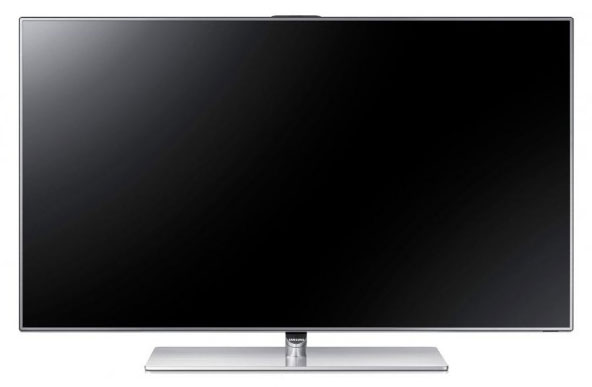
According to the specifications sheet, the F7000 features “Micro Dimming Pro” instead of the “Micro Dimming Ultimate” technology (which attempts to deliver pseudo-local dimming at a video processing level from an edge-lit LED LCD panel) found on the higher-up F8000. The 46F7000’s motion-compensated frame interpolation (MCFI) system is also rated lower, coming in at 800Hz CMR or Clear Motion Rate (the F8000’s is 1000Hz). Another notable omission from Series 7 is the dual 10W woofer that significantly enhanced low-end audio performance on the UE55F8000 we tested last month.
However, here at HDTVTest we prefer to let our calibration charts and benchmark tests do the talking despite what the spec sheets say. If the UE46F7000’s picture performance can match that of the pricier F8000, then it may represent better value for money than the latter for viewers who value image quality above all else.
Note: The specific unit we reviewed was the Samsung UE46F7000STXXU which is the United Kingdom 3-pin-plug model. Although we haven’t carried out our tests on the smaller, 40-inch Samsung UE40F7000 nor the bigger 55-inch UE55F7000, there shouldn’t be any drastic difference in picture quality (except perhaps 3D immersiveness due to different screen sizes) given similar specifications within the F7000 series.
Design
The first thing we noticed upon unboxing the Samsung UE46F7000 is that the truly unique arc stand bundled with the F8000 is gone, replaced instead by a more conventional table-top stand with a rectangular base. Nevertheless, there are still a number of swanky stylistic cues to satisfy owners that this is indeed a premium display.
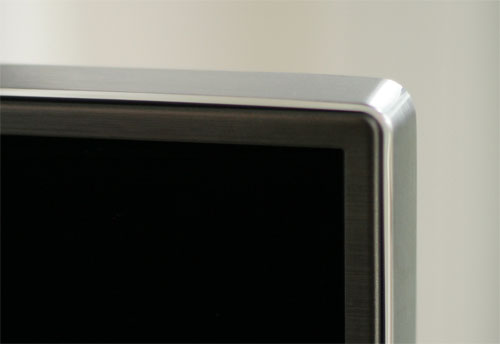
For starters, the bezel looks impossibly slim from the front, successfully creating the illusion that the screen’s larger than it actually is. Inspected from the top and sides, the bezel extends around 2mm deep, and sports a brushed metallic finish which complements that of the TV stand’s rectangular base. Just like the Series 8 LED, a press-to-pop-up camera is embedded along the top of the television.
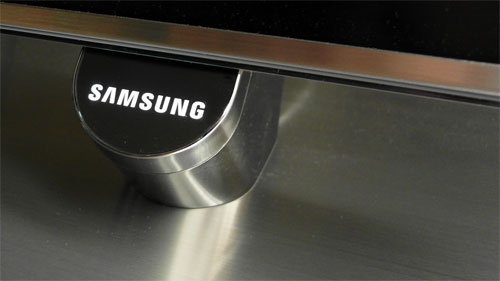
In another refreshing design endeavour, a Samsung logo – which can be tastefully lit (or not) – adorns the slanted top of the supplied pedestal stand. Assembly is easy, though swivelling is not possible. Overall build quality feels sufficiently solid befitting a mid-high-end flat-panel HDTV, with no untoward creaks nor cheap plastics.
Connections
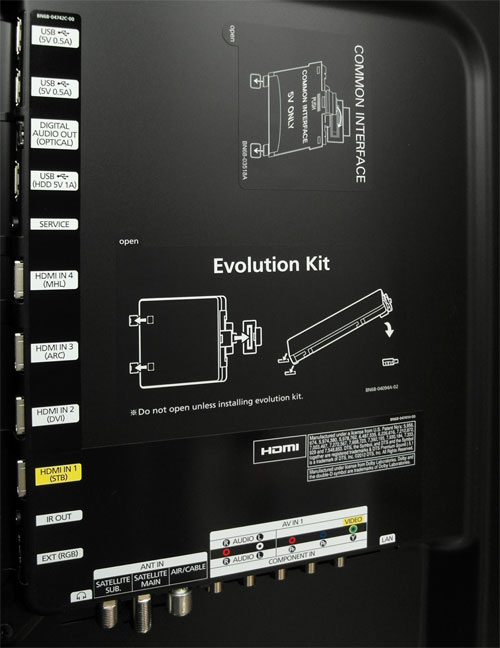 |
| Rear: 4x HDMI, 3x USB, component, RGB Scart, aerial & Freesat HD, LAN & audio outs |
Operations
Blasting through the user menu, EPG and the company’s new Smart Hub interface was an absolute cinch: we thoroughly appreciate UE46F7000’s lightning-fast responsiveness (presumably endowed by the onboard quad-core processor) which is a big help if you need to access numerous picture-affecting controls for calibration purposes like we do!
The on-screen menus and Smart TV platform on the 46in F7000 is the same as the ones available on the F8000. Since we’ve provided an indepth explanation of various picture options in our 55F8000 review, we won’t repeat it here – please refer to the relevant section if you haven’t read it, or need a refresher.
Remote Control
Just like the F8000, the Samsung 46F7000 comes with two remote controls. The first is a really luxurious-looking clicker with a central touchpad, subtly raised embedded buttons, and an inbuilt microphone to facilitate voice control for when you’re sitting too far away from the television.
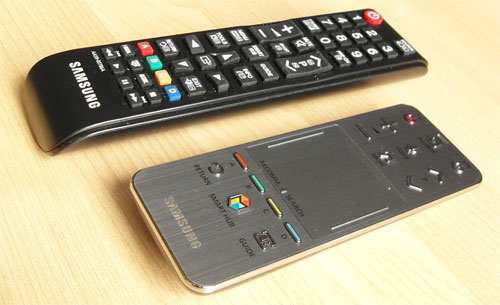
While this smartphone-like remote is opulent and actually intuitively usable once you pair it to the TV, we found ourselves preferring to use the more traditional, budget-style variant for day-to-day use and of course calibrating the UE46F7000.
Calibration
As with almost every Samsung flat-screen TV, [Movie Mode] is the picture preset which yielded an image closest to the Rec. 709 specifications used within the video and broadcast industry for HDTV.
Greyscale
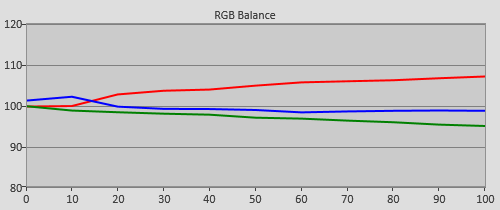 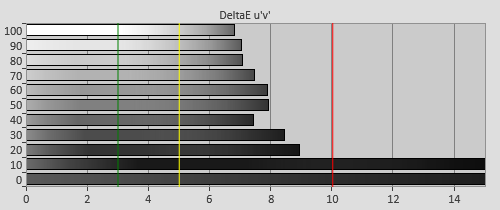 |
| Pre-calibration RGB tracking and delta errors (dEs) |
With [Colour Tone] left at its default value of “Warm 2” in [Movie Mode], there’s an excess of red component in the greys, which got progressively worse towards top-end luminance. Fortunately, Samsung provided not only 2-point [White Balance] controls, but also a [10p White Balance] submenu which allowed us to work our magic on the screen to produce as neutral a greyscale as possible.
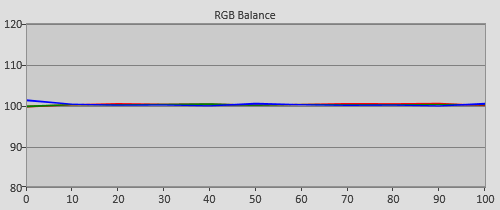 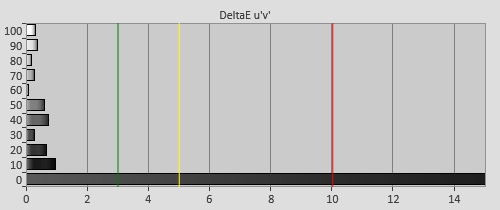 |
| Post-calibration RGB tracking and dEs in [Movie] mode |
We first used the 2-point [White Balance] controls to bring greyscale broadly in line with D65, then adjusted the RGB sliders in the [10p White Balance] submenu to finetune each 10% stimulus interval. The result is absolutely wonderful, with delta errors (dEs) of under 2 across the entire visible luminance range.
Gamma
Out of the box, overall gamma in [Movie Mode] tracked closer to 2.2 – this seems to be the target every TV manufacturer is aiming for – than 2.4 which has been decreed by ITU as the reference electro-optical transfer function (EOTF) for flat-panel HDTVs used for studio mastering in a dark room.
![Pre-calibrated Gamma tracking in [Movie] mode](/news/wp-content/uploads/2018/04/hdtv_Samsung-UE46F7000_pre-gamma.png) |
![Post-calibrated Gamma tracking in [Movie] mode](/news/wp-content/uploads/2018/04/hdtv_Samsung-UE46F7000_post-gamma.png) |
| Pre-calibration gamma tracking (2.2) | Post-calibration gamma tracking (2.4) |
After lowering the [Gamma] value (which affects the picture globally) to “-1“, and then repurposing the [10p White Balance] controls as our very own 10-point gamma editor, we eventually got gamma tracking linearly at 2.4. Cross-checking with a greyscale ramp pattern, we saw no evidence of excessive posterization despite these tinkerings – just a neutrally tinted, smooth transition from black to white which is crucial to delivering a realistic yet punchy picture.
Colour
With the advent of colour saturation tracking in CalMAN 5, we’ve tweaked our workflow slightly when it comes to colour calibration. We still give colour luminance/intensity/brightness our top priority, since colour decoding errors (particularly red push) are typically the most noticeable to viewers even without the help of a side-by-side comparison. But instead of focusing solely on 100% saturation points like we were originally constrained to, we now pay more attention to what happens inbetween (namely 25%, 50% and 75% saturation points) with the goal of levelling out the inaccuracies between the different points to achieve the best visual result, as these are more representative of the saturations commonly seen in real-world content.
On our Samsung UE46F7000 review unit, [Colour Space] “Auto” yielded reasonably accurate chromaticities at 100% saturation, but sub-100% saturation tracking points ran relatively hot (i.e. they appeared more saturated than they should be) across all six primary and secondary colours. To rectify this, we dialled down the global [Colour] control, aiming to place the 75%, 50% and 25% saturation points as close as possible to their reference coordinates.
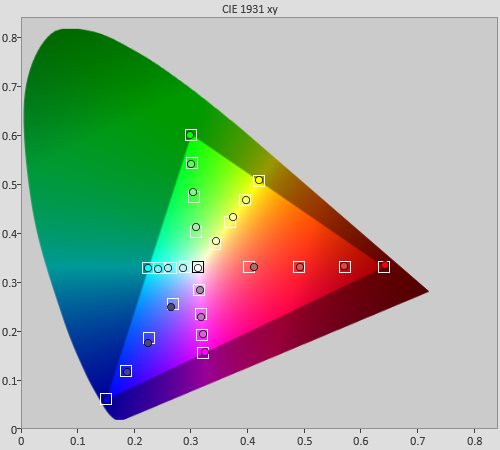 |
| Post-calibration colour saturation tracking |
Because the F7000 features such an excellent RGB-based colour management system accessible through [Colour Space] “Custom“, it would be criminal for us not to use it. Although the lack of negative headroom prevented us from adjusting the primary hues as much as we’d like, we achieved essentially flawless colour luminance, and what we would classify as excellent saturation tracking.
![Post-calibration Gamut Luminance levels in [Movie] mode](/news/wp-content/uploads/2018/04/hdtv_Samsung-UE46F7000_post-glum.png) |
| Post-calibration colour luminance (coloured bars=targets; black bars=measured values) |
Benchmark Test Results
| Dead pixels | None |
| Screen uniformity | Mild backlight bleed; a few vertical bands at the centre |
| Overscanning on HDMI | 0% with [Picture Size] set to “Screen Fit“ |
| Blacker than black | Passed |
| Calibrated black level (black screen) | 0 cd/m2 (LEDs shut off) |
| Calibrated black level (ANSI checkerboard) | 0.048 cd/m2 |
| Black level retention | Auto-dimming with full black screen |
| Primary chromaticity | Excellent |
| Scaling | Excellent |
| Video mode deinterlacing | Very effective jaggies reduction |
| Film mode deinterlacing | Passed 3:2 cadence over 480i & 1080i; and 2:2 over 576i |
| Viewing angle | Decent for VA LCD: washout occurs beyond 45° off-axis |
| Motion resolution | 1080 with [Motion Plus] engaged; 300 otherwise |
| Digital noise reduction | Excellent, optional |
| Sharpness | Defeatable edge enhancement |
| Luma/Chroma bandwidth (2D Blu-ray) | Full luma; chroma horizontally blurred in non-Game Mode |
| 1080p/24 capability | No judder in 2D; mild judder in 3D |
| Input lag (high-speed camera) | 46ms compared to lag-free CRT |
| Leo Bodnar input lag tester | 44ms |
| Full 4:4:4 reproduction (PC) | Yes, with 60hz signal and “PC” input label |
Power Consumption
| Default [Standard] mode | 79 watts |
| Calibrated [Movie] mode | 61 watts |
| Standby | <1 watt |



Great review as always, Vincent, and a big thank you for taking the issue of input lag seriously by even including measurements from both methods. A bit surprised to see that the Leo Bodnar gives a slightly faster reading than the old method since it’s usually the other way around.
Maybe i got luclky but i tested for judder when i got my Samsung E6500 using the opening scenes of Hugo and i did not notice any judder, maybe i’m just immune to it but i would have thought it would stick out like a sore thumb.
such as the first few minutes of the final chapter in the UK DVD of Bridget Jones: The Edge Of Reason (yes we have the movie, but only for the purpose of carrying out this test!)
http://www.youtube.com/watch?v=Qoxg_DcqhsA
Hi Vincent, solid review as always!
I’m very likely to purchase this model in this size (either this or the Philips 46PFL7007 which I can’t find a comprehensive review on), so just wanted to ask a couple of q’s?
Is the backlight uniformity on the F8000 better than the F7000?
In the conclusion section of the review you have written ” the Samsung F7000 does not support 24fps playback natively (i.e. there’ll be a bit of judder visible which can be smoothened by engaging [Motion Plus]” – How bad is the judder in 2D, as in would you notice it without looking for it?
Out the box gamma in movie mode has a peak at 0 and 100, what effect will this have on the picture until its calibrated or for those who may never calibrate & will you be sharing any of your settings for this tv, I haven’t seen any posted for the 2013 models reviewed thus far!? – Would be interested to see your Motion Plus custom setting amongst other things.
Always appreciated
JP
@Bjorn E: The high-speed camera figure of 46ms is an average – I took 10 readings ranging from 33ms to 65ms. If anything it’s a testament to the consistency of the Leo Bodnar device, but the jury is still out regarding the ACCURACY of the device with different types of display technologies.
@FoxyMulder: The judder is really, really subtle… now don’t go looking for it. :-)
@JP: Thanks for your kind words. Backlight uniformity varies from unit to unit even within the same range, but for what it’s worth, our UE55F8000 review sample exhibited slightly better uniformity than our UE46F7000 review sample.
There’s no judder for 1080p/24 2D playback, only in 3D.
We’re currently reviewing our policy of releasing calibrated settings.
Warmest regards
Vincent
Hi Vincent. I have a couple of questions regarding the game mode of the F7000, as I have recently purchased the 55F8000. One thing I that springs to attention when one is renaming the HDMI input from “game” to “pc” is the significantly reduced visual fidelity, the image is considerably softer – even bumping sharpness to 100 in “pc-mode” does not seem to bring it in line with the sharpness at 50 in game mode. Furthermore I have noticed that the screen fit (pixelmapping 1:1) is greyed out in the pc-mode, meaning that one can only select 16:9 or 4:3 – possibly resulting in an overscanned image? What were your findings regarding this on the F7000?
Hello. Please can you publish the exacts settings that you have made to achieve a (almost) perfect image.
Thanks
What Claudiu said, please!
Claudiu
29 June 2013 at 10:29 am
Hello. Please can you publish the exacts settings that you have made to achieve a (almost) perfect image.
Thanks
Hi Vincent,
Please could you publish the calibrated settings you used? Nowhere else on the net appears to have calibrated this model to the accuracy you have!
Thanks
In response to Manly Koolbrikc:
The game mode cranks up the brightness (and possibly the sharpness) so it’s not the most accurate image you can find. When you set the input to “pc” however, it is supposed to display the “purest” video source on the screen (no filters, no enhancements whatsoever), and don’t worry about the “16/9” thing, the image on “pc mode” is not overscanned.
Hi Vincent,
I was hoping to find the calibrated settings here. I got the basic settings pretty good but I have no clue how to calibrate the white balance. On standard the skin tones are too blue and on warm1 white is too red.
So if you can please post the calibrated settings here I would be happy and grateful too.
Thank you.
I am also hoping to see the calibration settings for this model! I recently purchased it and even if I’m somehow pleased with some calibration settings I got from the internet, I am still not at all pleased with those settings for 3D viewing…ghosting still occurs in most of the 3D HD TV stations I watch (eg : High TV) or some 3D movies….Please Vincent share your expertise with us! Thank you!
Hello Vincent,
Great article yours!!!
I can’t find any calibration settings for this model to get the best results. I always get too red or too blue.
Can I please know yours? That would be great!
I also have problems of ghosting/crosstalk in 99% of 3d content. Do you think it is normal or just my tv?
Please share with us :)
Thank you :)
Hi,
can you tell me somebody if F7000 has the same problem with motion hiccup as F8000.I had F8000 for a while and motion hiccup after scene cuts or after change of camera movement bothered me a lot.
Thanks